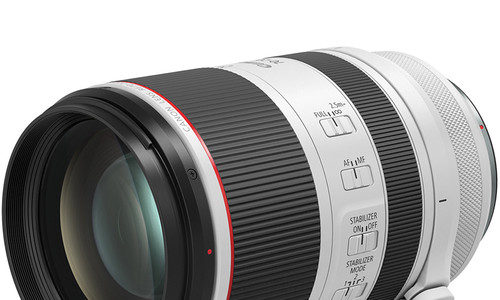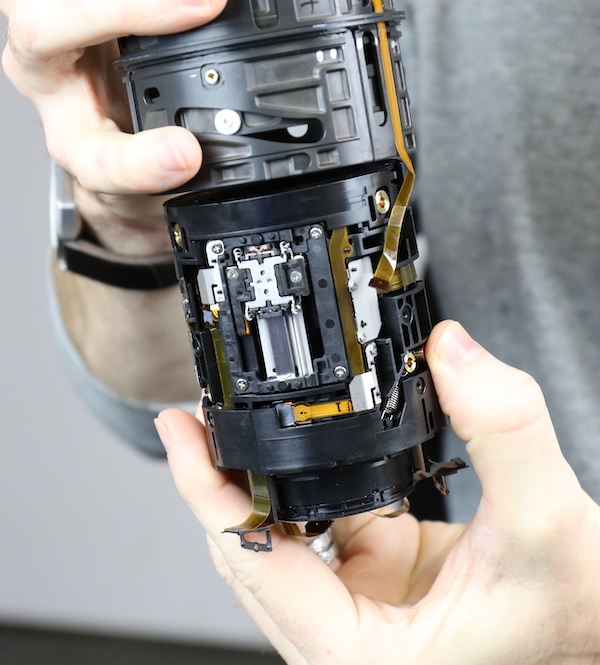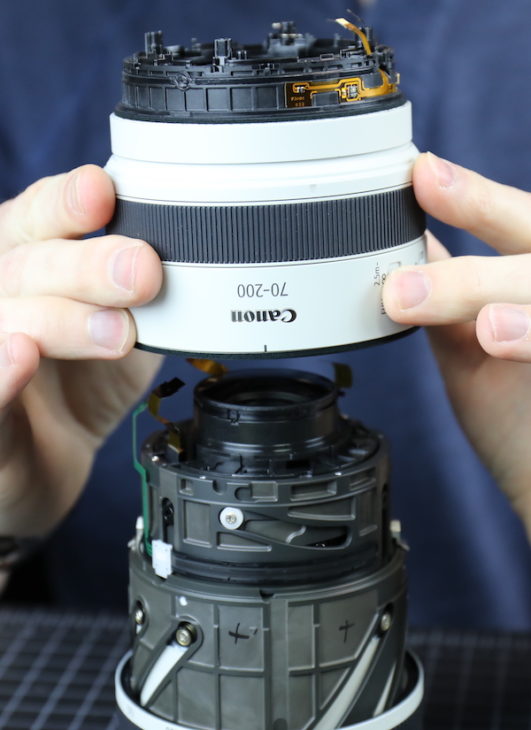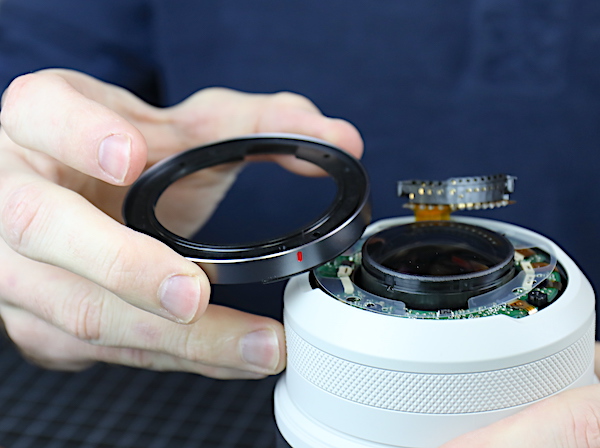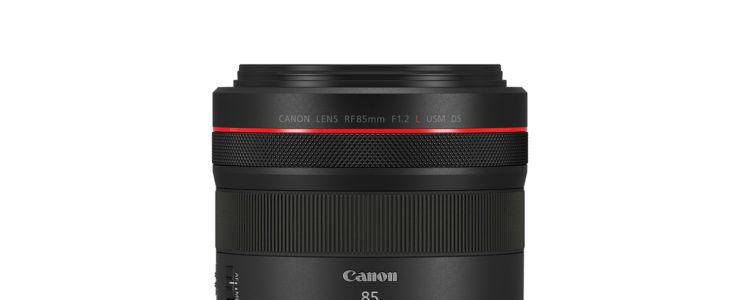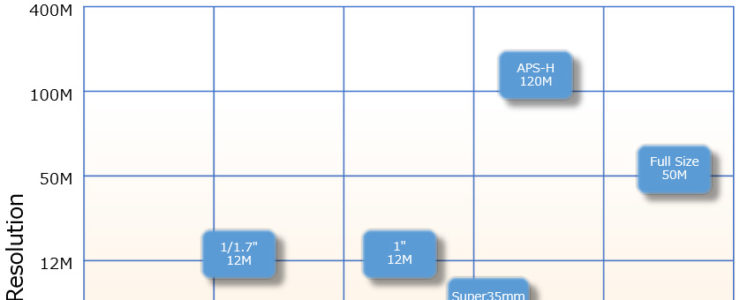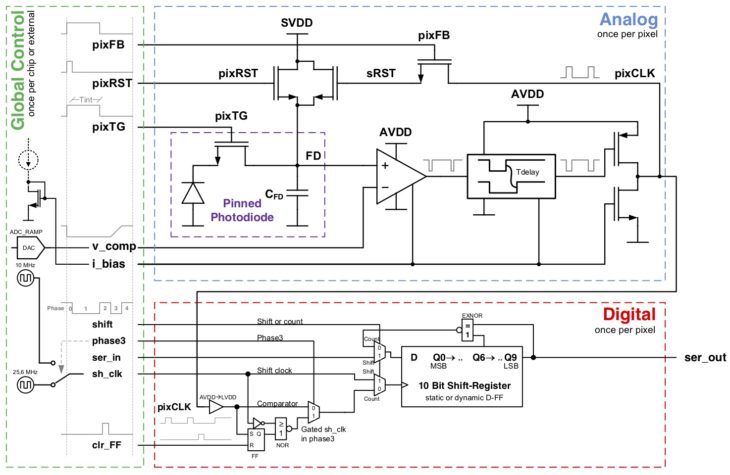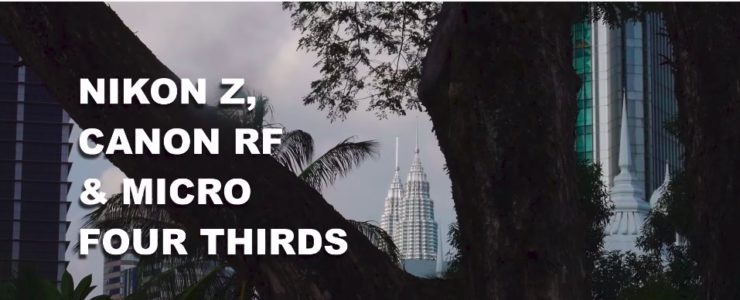Canon added five new specialised image sensors to their lineup.
Canon’s superspecialised image sensors are used in industry applications, science, space imagery, and surveillance. To see our coverage of Canon specialised image sensors click here.
Canon 1 Inch 12MP CMOS 4K Sensor
Color CMOS solid-state image sensor, 12 million effective pixels in a square pixel array. Supports read speeds of 24 fps when reading all pixels.
- Filter Type – RGB
- Sensitivity – 22,000 e/lx/sec @Analog gain x1 (TBD)
- Sensor Size – 1 inch
- Number of Effective Pixels – 4000x 3000 (Horizontal x Vertical)
- Pixel Size – 3.2 um x 3.2 um
- Shutter – Rolling shutter 12 bit, 24 fps (All Pixels)
- Maximum Frame Rate – 10 bit, 60 fps (4K2K)
- Saturation 22,000 e (TBD) @ Analog gain x 1
- Dark Random Noise – 2.8 e rms @Analog gain x16 (TBD)
- Dark Current – 17 e/sec (TBD) @package reverse side 60℃
- Drive Frequency – 27 MHz (recommended)
- Output Channels – Data: 12 lanes, Clock: 2 lanes
- Output Format – LVDS output maximum 648 Mbps @12 bit
- Power Consumption – 540 mW(Typ.) @All pixels readout 24fps (12bit)
- Power Supply Voltages 3.3V, 1.8 V
- Package Type – 150 pin ceramic LGA
- Package Size – 25.10 mm x 22.20 mm x 2.99 mm
Canon 1/1.7 Inch 12MP CMOS Sensor
Color CMOS solid-state image sensor, 9.3mm measured diagonally, 12 million effective pixels in a square pixel array. Supports 4K/2K video at 30 fps and 12MP still images.
- Filter Type – RGB
- Sensitivity – 8,900 e/lx/sec @Analog gain x1 (TBD)
- Sensor Size – 1 / 1.7 inch
- Number of Effective Pixels 4000x 3000 (Horizontal x Vertical)
- Pixel Size – 1.86 um x 1.86 um
- Shutter – Rolling shutter 12 bit, 15 fps (All Pixels)
- Maximum Frame Rate – 11 bit, 30 fps (4K2K)
- Saturation – 12,000 e (TBD) @Analog gain x1
- Dark Random Noise – 1.3 e rms @Analog gain x16 (TBD)
- Dark Current – 7 e/sec (TBD) @package reverse side 60℃
- Drive Frequency – 27 MHz (recommended)
- Output Channels – Data: 12 lanes, Clock: 4 lanes
- Output Format – LVDS output maximum 648 Mbps @12bit
- Power Consumption – 0.52 W (Typ.) @All pixels readout 15 fps (12bit)
- Power Supply Voltages 3.5V, 3.4V, 3.3 V, 1.8 V
- Package Type – 129 pin ceramic LGA
- Package Size – 15.80 mm x 14.90 mm x 2.10 mm
Canon 1/2.32 Inch 2.8MP High Dynamic Range CMOS Sensor
CMOS type of solid-state image sensor (3U3MRXSAA), 1/2.32″ pixel array of 2.81M. Rolling electronic shutter for video to control the charge storage period. Can output effective 1936 x 1456 pixels video at 60 fps and 12bit via 4 channels of digital signal output. Includes HDR ( High Dynamic Range) drive features. 3U3MRXSAAC has an RGB on-chip color filter.
- Filter Type – RGB
- Sensitivity (e/lx/sec) 25,000 (Green) @Analog gain x1 (TBD)
- Sensor Size – 1 / 2.32 inch equivalent
- Number of Effective Pixels 1936 x 1456 (Horizontal x Vertical)
- Pixel Size – 3.2 um x 3.2 um
- Scan Type – Progressive scan
- Shutter – Rolling shutter 120 dB, HDR
- Dynamic Range – 75dB, Normal
- Maximum Frame Rate (All Pixels) – 60 fps, Normal, 30 fps, HDR
- Operating Temperature – -40℃ ~ 105℃(-40°F ~ 221°F)
- Saturation – 23,000 e @Analog gain x1 (TBD)
- Dark Random Noise – 2.7 e rms @Analog gain x4 (TBD)
- Dark Current – 13 e/sec @Analog gain x 1, 60℃ (TBD), TBD @room temperature
- Drive Frequency – 24MHz (recommended)
- Output Channels – Data: 4 lanes, Clock: 1 lane MIPI-CSI2 output maximum 576 Mbps
- Output Format – @in all-pixel operating mode 12bit, 60fps
- Power Consumption – 300mW (Typ.) @using all pixels 60 fps (TBD)
- Power Supply Voltages 3.3 V, 1.8 V, 1.2V
- Package Type – 94 pin ceramic LGA
- Package Size – 15.07 mm x 13.37 mm x 2.74 mm
Canon Super 35mm 9.34MP 4K CMOS Sensor
Color CMOS solid-state image sensor, Super 35mm (30mm diagonally), 9.24 million effective pixels in a square pixel array. Supports speeds of 60 fps when reading all pixels, high-sensitivity 4K.
- Filter Type – RGB
- Sensitivity – 72,000 e/lx/sec @Analog gain x1 (TBD)
- Sensor Size – super 35mm (Diagonal30 mm)
- Number of Effective Pixels 4112x 2248 (Horizontal x Vertical)
- Pixel Size – 6.4 um x 6.4 um
- Shutter – Rolling shutter
- Maximum Frame Rate 12bit, 60 fps (All Pixels)
- Saturation – 39,000 e(TBD) @Analog gain x1
- Dark Random Noise – 2.7 e rms @Analog gain x 8 (TBD)
- Dark Current – 54 e/sec(TBD) @package reverse side 60℃
- Drive Frequency – 72 MHz (recommended)
- Output Channels – Data: 24 lanes, Clock: 2 lanes
- Output Format – LVDS output maximum 576 Mbps @12 bit
- Power Consumption – 2 W (Typ.) @All pixels readout 60 fps
- Power Supply Voltages 3.3V, 2.1 V, 1.8 V, 1.0V, 0.85V, -1.2V
- Package Type – 154 pin ceramic LCC
- Package Size – 46.00 mm x 38.00 mm x 3.59 mm
Canon Full Frame 50MP CMOS Sensor
Full frame CMOS solid-state color image sensor (43.2mm diagonally), 50.6 million effective pixels in asquare pixel array. High definition, low noise, and reduced dark current.
- Filter Type – RGB
- Sensitivity – 32,000 e/lx/sec @Analog gain x16 (TBD)
- Sensor Size – 35mm Full size (36 mm x 24 mm)
- Number of Effective Pixels 8688x 5792 (Horizontal x Vertical)
- Pixel Size – 4.14 um x 4.14 um
- Shutter – Rolling shutter
- Maximum Frame Rate – 6.8 fps (All Pixels)
- Saturation – 38,000 e (TBD)
- Dark Random Noise – 2.5 e rms @Analog gain x16 (TBD)
- Dark Current – 9.6 e/sec (TBD) @package reverse side 60℃
- Drive Frequency – 24 MHz (recommended)
- Output Channels – Data: 16 ch
- Output Format – 16 ch analog outputs
- Power Consumption – 1.5 W (Typ.) @All pixels readout 6.8 fps
- Power Supply Voltages 5.5V, 4.8V, 3.3V, 2.0V, 1.8 V, 1.5 V, 1.3V, 1.2V, -1.4V
- Package Type – 104 pin ceramic QFP
- Package Size – 55.2 mm x 44.35 mm x 2.74 mm
Below you see the full list of Canon’s specialised image sensors, and their area of application. The first five image sensors in the list are the new ones (in bold)
| Product | Pixel
type | Image
Size | Res | Pixel
Size
(μm) | Chroma | IF | Max Frame Rate
(fps) | Application |
|---|
| 2.8M HDR color | Rolling-shutter | 1 / 2.32 “ | 2.8M | 3.2 | RGB | MIPI CSI2 | 60 | Surveillance |
Full size 50M
color | Rolling-shutter | 35mm Full Size | 50M | 4.14 | RGB | Analog
(serial) | 6.8 | Industly
/ Surveillance |
1 / 1.7 inch
12M color | Rolling-shutter | 1 / 1.7 “ | 12M | 1.86 | RGB | LVDS | 30
(4K2K) | Surveillance |
1 inch 12M
color | Rolling-shutter | 1 “ | 12M | 3.2 | RGB | LVDS | 60
(4K2K) | Surveillance |
Super35mm
4K color | Rolling-shutter | Super
35mm | 10M | 6.4 | RGB | LVDS | 60 | Surveillance |
| 5MGS monochrome | Global-shutter | 2/3 “ | 5M | 3.4 | B / W | LVDS | 120 | Industly |
| 5MGS color | Global-shutter | 2/3 “ | 5M | 3.4 | RGB | LVDS | 120 | Industly
/ Surveillance |
| 5MGS RGBIR | Global-shutter | 2/3 “ | 5M | 3.4 | RGB / IR | LVDS | 120 | Industly
/ Life science |
| 120M monochrome | Rolling-shutter | APS-H | 120M | 2.2 | B / W | LVDS | 9.4 | Industly |
| 120M RGB | Rolling-shutter | APS-H | 120M | 2.2 | RGB | LVDS | 9.4 | Surveillance
/ Industly |
| 120M RGBIR | Rolling-shutter | APS-H | 120M | 2.2 | RGB / IR | LVDS | 9.4 | Life science
/ Surveillance |
35mm FHD
monochrome | Rolling-shutter | 35mm Full Size | 2M | 19 | B / W | Analog
(serial) | 115
(FullHD) | Space science
/ Surveillance |
35mmFHD
RGB | Rolling-shutter | 35mm Full Size | 2M | 19 | RGB | Analog
(serial) | 115
(FullHD) | Space science
/ Surveillance |

